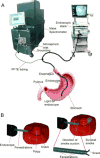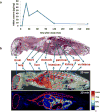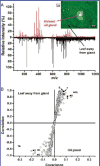Ambient mass spectrometry in metabolomics
- PMID: 28792022
- PMCID: PMC5729766
- DOI: 10.1039/c7an00700k
Ambient mass spectrometry in metabolomics
Abstract
Since the introduction of desorption electrospray ionization (DESI) mass spectrometry (MS), ambient MS methods have seen increased use in a variety of fields from health to food science. Increasing its popularity in metabolomics, ambient MS offers limited sample preparation, rapid and direct analysis of liquids, solids, and gases, in situ and in vivo analysis, and imaging. The metabolome consists of a constantly changing collection of small (<1.5 kDa) molecules. These include endogenous molecules that are part of primary metabolism pathways, secondary metabolites with specific functions such as signaling, chemicals incorporated in the diet or resulting from environmental exposures, and metabolites associated with the microbiome. Characterization of the responsive changes of this molecule cohort is the principal goal of any metabolomics study. With adjustments to experimental parameters, metabolites with a range of chemical and physical properties can be selectively desorbed and ionized and subsequently analyzed with increased speed and sensitivity. This review covers the broad applications of a variety of ambient MS techniques in four primary fields in which metabolomics is commonly employed.
Figures







Similar articles
-
A comprehensive high-resolution mass spectrometry approach for characterization of metabolites by combination of ambient ionization, chromatography and imaging methods.Rapid Commun Mass Spectrom. 2014 Aug 30;28(16):1779-91. doi: 10.1002/rcm.6960. Rapid Commun Mass Spectrom. 2014. PMID: 25559448
-
Imaging the Unimaginable: Desorption Electrospray Ionization - Imaging Mass Spectrometry (DESI-IMS) in Natural Product Research.Planta Med. 2018 Jul;84(9-10):584-593. doi: 10.1055/s-0044-100188. Epub 2018 Jan 31. Planta Med. 2018. PMID: 29388184 Free PMC article. Review.
-
Biomarker Identification in Liver Cancers Using Desorption Electrospray Ionization Mass Spectrometry (DESI-MS) Imaging: An Approach for Spatially Resolved Metabolomics.Methods Mol Biol. 2024;2769:199-209. doi: 10.1007/978-1-0716-3694-7_15. Methods Mol Biol. 2024. PMID: 38315399
-
Spatial metabolomics method to reveal differential metabolomes in microregions of Panax quinquefolius roots by using ultra-performance liquid chromatography quadrupole/time of flight-mass spectrometry and desorption electrospray ionization mass spectrometry imaging.Food Chem. 2024 Mar 1;435:137504. doi: 10.1016/j.foodchem.2023.137504. Epub 2023 Oct 5. Food Chem. 2024. PMID: 37813026
-
Ambient ionization MS for bioanalysis: recent developments and challenges.Bioanalysis. 2015;7(15):1901-23. doi: 10.4155/bio.15.116. Bioanalysis. 2015. PMID: 26295990 Review.
Cited by
-
Vibrating Sharp-edge Spray Ionization (VSSI) for voltage-free direct analysis of samples using mass spectrometry.Rapid Commun Mass Spectrom. 2021 Jan;35 Suppl 1(Suppl 1):e8232. doi: 10.1002/rcm.8232. Epub 2018 Aug 19. Rapid Commun Mass Spectrom. 2021. PMID: 29993155 Free PMC article.
-
Promise of spatially resolved omics for tumor research.J Pharm Anal. 2023 Aug;13(8):851-861. doi: 10.1016/j.jpha.2023.07.003. Epub 2023 Jul 13. J Pharm Anal. 2023. PMID: 37719191 Free PMC article. Review.
-
The Ion Source of Nitrogen Direct Analysis in Real-Time Mass Spectrometry as a Highly Efficient Reactor: Generation of Reactive Oxygen Species.J Am Soc Mass Spectrom. 2019 Apr;30(4):581-587. doi: 10.1007/s13361-019-02132-7. Epub 2019 Feb 19. J Am Soc Mass Spectrom. 2019. PMID: 30784004
-
Neutral Desorption Extractive Electrospray Ionization Mass Spectrometry Analysis Sputum for Non-Invasive Lung Adenocarcinoma Detection.Onco Targets Ther. 2021 Jan 15;14:469-479. doi: 10.2147/OTT.S269300. eCollection 2021. Onco Targets Ther. 2021. PMID: 33488101 Free PMC article.
-
The effect of sample age on the metabolic information extracted from formalin-fixed and paraffin embedded tissue samples using desorption electrospray ionization mass spectrometry imaging.J Mass Spectrom Adv Clin Lab. 2021 Oct 28;22:50-55. doi: 10.1016/j.jmsacl.2021.10.004. eCollection 2021 Nov. J Mass Spectrom Adv Clin Lab. 2021. PMID: 34939055 Free PMC article.
References
-
- Fiehn O, Kopka J, Dormann P, Altmann T, Trethewey RN, Willmitzer L. Nature Biotechnol. 2000;18:1157–1161. - PubMed
-
- Nicholson JK, Lindon JC. Nature. 2008;455:1054–1056. - PubMed
-
- Han J, Datla R, Chan S, Borchers CH. Bioanalysis. 2009;1:1665–1684. - PubMed
-
- Monge ME, Harris GA, Dwivedi P, Fernandez FM. Chem Rev. 2013;113:2269–2308. - PubMed
Publication types
MeSH terms
Grants and funding
LinkOut - more resources
Full Text Sources
Other Literature Sources

